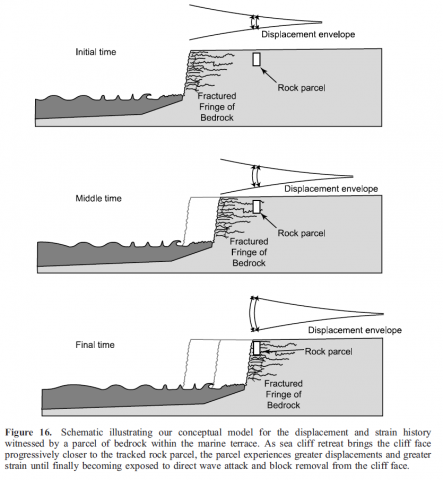Description:
Evolution of a tectonically active coast is driven by geomorphically destructive energy supplied by ocean waves. Wave energy is episodic and concentrated; sea cliffs are battered by the geomorphic wrecking ball every 4–25 s. We measure the response of sea cliffs to wave assault by sensing the ground motion using near-coastal seismometers. Sea cliffs respond to waves in two distinct styles. High-frequency motion (20 Hz) reflects the natural frequency of the sea cliff as it rings in response to direct wave impact. Low-frequency motion in the 0.1–0.05 Hz (10–20 s) band consistently agrees with the dominant nearshore wave period. Integrating microseismic velocities suggests 50 mm and 10 mm displacements in horizontal and vertical directions, respectively. Displacement ellipsoids exhibit simultaneous downward and seaward sea cliff motion with each wave. Video footage corroborates the downward sea cliff flex in response to the imposed water load on the wave cut platform. Gradients in displacement amplitudes documented using multiple seismometers suggest longitudinal and shear strain of the flexing sea cliff on the order of 0.5–4 m strains during each wave loading cycle. As this sea cliff flexure occurs approximately 3 million times annually, it has the potential to fatigue the rock through cyclical loading. Local sea cliff retreat rates of 10 cm/yr imply that a given parcel of rock is flexed through roughly 109 cycles of increasing amplitude before exposure to direct wave attack at the cliff face.
Image:

Attribution:
Adams, P. N., C. D. Storlazzi, and R. S. Anderson (2005), Nearshore wave-induced cyclical flexing of sea cliffs, J. Geophys. Res., 110, F02002, doi:10.1029/2004JF000217.
Equipment:
Method: